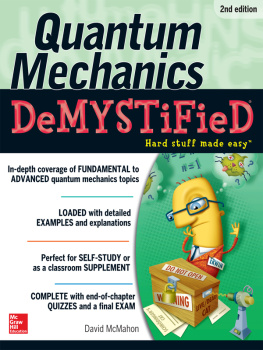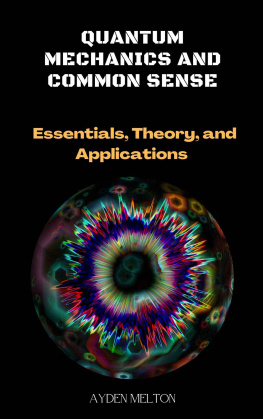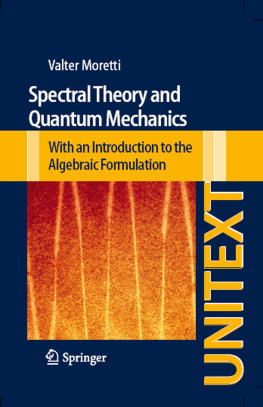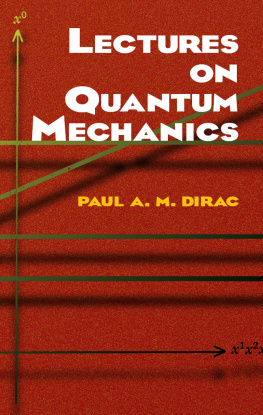Paul R. Berman - Introductory Quantum Mechanics
Here you can read online Paul R. Berman - Introductory Quantum Mechanics full text of the book (entire story) in english for free. Download pdf and epub, get meaning, cover and reviews about this ebook. year: 0, publisher: Springer International Publishing, genre: Children. Description of the work, (preface) as well as reviews are available. Best literature library LitArk.com created for fans of good reading and offers a wide selection of genres:
Romance novel
Science fiction
Adventure
Detective
Science
History
Home and family
Prose
Art
Politics
Computer
Non-fiction
Religion
Business
Children
Humor
Choose a favorite category and find really read worthwhile books. Enjoy immersion in the world of imagination, feel the emotions of the characters or learn something new for yourself, make an fascinating discovery.
- Book:Introductory Quantum Mechanics
- Author:
- Publisher:Springer International Publishing
- Genre:
- Year:0
- Rating:4 / 5
- Favourites:Add to favourites
- Your mark:
- 80
- 1
- 2
- 3
- 4
- 5
Introductory Quantum Mechanics: summary, description and annotation
We offer to read an annotation, description, summary or preface (depends on what the author of the book "Introductory Quantum Mechanics" wrote himself). If you haven't found the necessary information about the book — write in the comments, we will try to find it.
Introductory Quantum Mechanics — read online for free the complete book (whole text) full work
Below is the text of the book, divided by pages. System saving the place of the last page read, allows you to conveniently read the book "Introductory Quantum Mechanics" online for free, without having to search again every time where you left off. Put a bookmark, and you can go to the page where you finished reading at any time.
Font size:
Interval:
Bookmark:

UNITEXT for Physics series, formerly UNITEXT Collana di Fisica e Astronomia, publishes textbooks and monographs in Physics and Astronomy, mainly in English language, characterized of a didactic style and comprehensiveness. The books published in UNITEXT for Physics series are addressed to graduate and advanced graduate students, but also to scientists and researchers as important resources for their education, knowledge and teaching.
More information about this series at http://www.springer.com/series/13351

This Springer imprint is published by Springer Nature
The registered company is Springer International Publishing AG
The registered company address is: Gewerbestrasse 11, 6330 Cham, Switzerland
I would like to dedicate this book to Debra Berman, my wife of 30+ years, for her support and positive outlook on life.
This book is based on junior and senior level undergraduate courses that I have given at both New York University and the University of Michigan. You might ask, in heavens name, why anyone would want to write yet another introductory text on quantum mechanics. And you would not be far off base with this assessment. There are many excellent introductory quantum mechanics texts. Moreover, with the material available on the internet, you can access almost any topic of your choosing. Therefore, I must agree that there are probably no compelling reasons to publish this text. I have undertaken this task mainly at the urging of my students, who felt that it would be helpful to students studying quantum mechanics.
For the most part, the approach taken is a traditional one. I have tried to emphasize the relationship of the quantum results with those of classical mechanics and classical electromagnetism. In this manner, I hope that students will be able to gain physical insight into the nature of the quantum results. For example, in the study of angular momentum, you will see that the absolute squares of the spherical harmonics can be given a relatively simple physical interpretation. Moreover, by using the effective potential in solving problems with spherical symmetry, I am able to provide a physical interpretation of the probability distributions associated with the eigenfunctions of such problems and to interpret the structures seen in scattering cross sections. I also try to stress the time-dependent aspects of problems in quantum mechanics, rather than focus simply on the calculation of eigenvalues and eigenfunctions.
The book is intended to be used in a year-long introductory course. Chapters , that contains an Errata, Mathematica subroutines, and some additional material.
The problems form an integral part of the book. Many are standard problems, but there are a few that might be unique to this text. Quantum mechanics is a difficult subject for beginning students. I often tell them that falling behind in a course such as this is a disease from which it is difficult to recover. In writing this book, my foremost task has been to keep the students in mind. On the other hand, I know that no textbook is a substitute for a dedicated instructor who guides, excites, and motivates students to understand the material.
I would like to thank Bill Ford, Aaron Leanhardt, Peter Milonni, Michael Revzen, Alberto Rojo, and Robin Shakeshaft for their insightful comments. I would also like to acknowledge the many discussions I had with Duncan Steel on topics contained in this book. Finally, I am indebted to my students for their encouragement and positive (as well as negative) feedback over the years. I am especially grateful to the Fulbright foundation for having provided the support that allowed me to offer a course in quantum mechanics to students at the College of Science and Technology at the University of Rwanda. My interactions with these students will always remain an indelible chapter of my life.
As a science or engineering major, you are about to embark on what may be the most important course of your undergraduate career. Quantum mechanics is the foundation on which our current picture of the structure of matter is built. For students, an introductory course in quantum mechanics can be difficult and frustrating. When you studied Newtonian physics, it was easy to envision experiments involving the motion of particles moving under the influence of forces. Electromagnetism and optics were a bit more abstract once the concept of fields was introduced, but you are familiar with many optical effects such as colors of thin films, the rainbow, and diffraction from single or double slits. In quantum mechanics, it is more difficult conceptually to understand what is going on since you have very little day to day experience with the wave nature of matter. However, you can exploit your knowledge of both classical mechanics and optics to get a better feel for quantum mechanics.
Font size:
Interval:
Bookmark:
Similar books «Introductory Quantum Mechanics»
Look at similar books to Introductory Quantum Mechanics. We have selected literature similar in name and meaning in the hope of providing readers with more options to find new, interesting, not yet read works.
Discussion, reviews of the book Introductory Quantum Mechanics and just readers' own opinions. Leave your comments, write what you think about the work, its meaning or the main characters. Specify what exactly you liked and what you didn't like, and why you think so.










